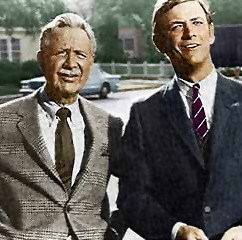6.8 /10 1 Votes6.8
5.9/10 TV Final episode date 28 March 1968 | 7.7/10 IMDb Genre Sitcom First episode date 6 September 1967 | |||||||||||||||||||||||||||||||||
 | ||||||||||||||||||||||||||||||||||
Created by Roswell RogersEd Simmons Written by Stan CutlerPeggy Chantler DickRobert LeesEd SimmonsGene ThompsonSkip Webster Directed by John ErmanPaul Junger WittRichard Kinon Starring Monte MarkhamArthur O'ConnellFrank Maxwell Network American Broadcasting Company Cast | ||||||||||||||||||||||||||||||||||
The Second Hundred Years is an American sitcom starring Monte Markham which aired on the ABC television network for one season from September 6, 1967 to March 28, 1968 (repeats were shown through September 1968).
Contents
Synopsis
The Second Hundred Years was what was called a "high-concept" show—one which was based on circumstances which were extremely unlikely to occur in real life. The concept here was that one Lucius "Luke" Carpenter had left for Alaska in 1900 as part of a gold rush, but soon after his arrival was buried in a glacial avalanche. His burial was evidently so complete and so rapid that he survived in a state of suspended animation for 67 years. He was then thawed out and soon brought to the home of his now-elderly son, Edwin (portrayed by Arthur O'Connell), a land developer in Woodland Oaks, California. In the pilot episode, a heavily-bandaged Luke awakens in Edwin's house and thinks Edwin is a gold robber. After removing his bandages, a bearded Luke dons his prospector's outfit and grabs his rifle in attempt to find the sheriff to report the robber, but accidentally turns on a TV, which is playing a western. Luke comments "There's a midget in a box challenging me to a duel" and attacks the TV set. Outdoors, Luke, thinking he is in Fairbanks, Alaska, is confused and scared by automobiles, as well as people's strange fashions. Accidentally pointing a rifle at a woman gets the attention of the police, who return him to Edwin. Starting to grasp what has happened, Luke decides to assimilate to 1967 California by shaving off his beard and wearing more modern clothes, which makes him look very much like his grandson Ken. After some confusion, Luke decides it is best not to burden his family and strikes out on his own by taking a train to San Francisco, but is stopped by Edwin, who convinces his father to live with him and they will take a flight to San Francisco in order to help show that Luke has been given a unique gift, a chance to see the fruits of his generation's sacrifices through the advances of the latter 20th Century. The Army officer who oversaw Luke's unfreezing holds Luke, Edwin and Ken to a state secrecy act, as the Army does not wish for this to be public until the medical corps can fully comprehend why Luke survived. When told the order came from the top, Luke responds "if President McKinley says so it is good enough for me!"
The humor centered around how Luke was younger, both in appearance and attitude, than both his son, who was 67 (referenced in the pilot), but also his grandson Ken, who at 33 was the exact age at which Luke had disappeared and been preserved, and who was a near double for his grandfather (not surprising, as both characters were portrayed by Markham). Difficulty adjusting to all of the technology of the modern era aside, Luke, who was an affable, light-hearted sort, was in some ways more at home in his new world than Edwin. Other times it would play on how both men had buttoned-down ways, but how Luke is treated differently than Edwin for it, such as when Luke considers remarrying and courts a young woman by taking her out on a date in a horse and buggy, to which he is treated as an old-fashioned romantic.
Reception
The series drew overwhelmingly negative reviews, but premiered with strong ratings. By October, however, the series dropped to the bottom 25. In March 1968, the series was moved to Thursday nights (replacing Batman) but was canceled by ABC a little more than a week later.
